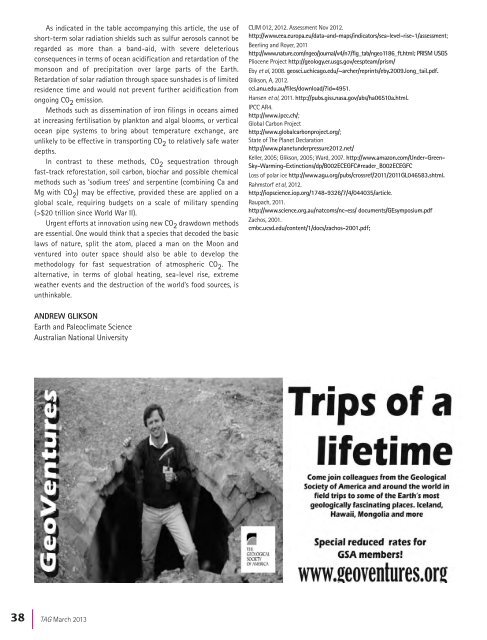Relations between CO 2 rise rates and mean global temperature rise rates during warming periods including the Paleocene–Eocene Thermal Maximum (PETM),Oligocene, Miocene, glacial terminations, Dansgaard–Oeschger (D–O) cycles and the post-1750 period (after Glikson, 2012).Since the 18th century, and in particular since about 1975, theEarth system has been shifting away from Holocene (10 000 yearsago to the present) conditions that allowed agriculture, previouslynot possible due to instabilities in the climate and extreme weatherevents. The shift is most clearly manifested by the loss <strong>of</strong> polar ice(Loss <strong>of</strong> polar ice article, 2001). Sea-level rises have beenaccelerating, with a total <strong>of</strong> more than 20 cm since 1880 and about6 cm since 1990 (CLIM 012, 2012; Rahmstorf et al, 2012).For a temperature rise <strong>of</strong> 2–3°C, to which the climate iscommitted if sulfur aerosol emission discontinues (see accompanyingfigure on mean CO 2 from ice cores), sea levels would reachPliocene-like levels <strong>of</strong> 25 ± 12 m, with lag effects due to ice sheethysteresis. With global CO 2 -e levels at about 470 ppm, just underthe upper stability limit <strong>of</strong> the Antarctic ice sheet, and with thecurrent rate <strong>of</strong> CO 2 emissions from fossil-fuel combustion, cementproduction, land-clearing and fires <strong>of</strong> about 9.7 GtC in 2010(Raupach, 2011), it is clear that global civilisation is at a tippingpoint, facing the following alternatives:l With carbon reserves sufficient to raise atmospheric CO 2 levelsto above 1000 ppm, continuing business-as-usual emissions canonly result in advanced melting <strong>of</strong> the polar ice sheets, acorresponding rise <strong>of</strong> sea level on the scale <strong>of</strong> metres to tens <strong>of</strong>metres and continental temperatures rendering agriculture, in itspresent distribution and extent, unlikely.l With atmospheric CO 2 at about 400 ppm, abrupt decrease incarbon emissions may no longer be sufficient to prevent currentfeedbacks (melting <strong>of</strong> ice, methane release from permafrost,fires). Attempts to stabilise the climate would require globalefforts at CO 2 drawdown, using a range <strong>of</strong> methods includingglobal reforestation, extensive biochar application, chemical CO 2sequestration (using sodium hydroxide, serpentine and newinnovations) and burial <strong>of</strong> CO 2 .SO 2 injectionsSpace sunshades/mirrorsOcean iron filing fertilisation enhancingphytplanktonOcean pipe system for verticalcirculation <strong>of</strong> cold water to enhance CO 2sequestration‘Sodium trees’–NaOH liquid in pipe systemsequestering CO 2 to Na2CO3, separation and burial<strong>of</strong> CO 2Soil carbon burial/biocharSerpentine CO 2 sequestrationCheap and rapid applicationRapid application. No direct effect on oceanchemistryCO 2 sequestrationCO 2 sequestrationCO 2 sequestration estimated by Handsen et al.(2008) at $300 per ton CO 2Effective means <strong>of</strong> controlling the carbon cycle(plants+soil exchange more than 100 GtC/year withthe atmosphere)CO 2 sequestrationShort multi-year atmospheric residence time;ocean acidification; retardation <strong>of</strong> precipitationand <strong>of</strong> monsoonsLimited space residence time. Uncertain positioningin space. Does not mitigate ongoing oceanacidification by carbon emissionsNo evidence that dead phytoplankton would notrelease CO 2 back to the ocean surfaceNo evidence <strong>of</strong> cold water would circulate back toocean depths where CO 2 is prevented fromreturning to the surfaceUnproven efficiency; need for CO 2 burial; $trillionsexpense (though no more than current militaryexpenses)Requires a huge international effort by a workforce<strong>of</strong> millions <strong>of</strong> farmersPossible scale unknownMain proposed solar mitigation and atmospheric carbon sequestration methods.<strong>TAG</strong> March 2013| 37
As indicated in the table accompanying this article, the use <strong>of</strong>short-term solar radiation shields such as sulfur aerosols cannot beregarded as more than a band-aid, with severe deleteriousconsequences in terms <strong>of</strong> ocean acidification and retardation <strong>of</strong> themonsoon and <strong>of</strong> precipitation over large parts <strong>of</strong> the Earth.Retardation <strong>of</strong> solar radiation through space sunshades is <strong>of</strong> limitedresidence time and would not prevent further acidification fromongoing CO 2 emission.Methods such as dissemination <strong>of</strong> iron filings in oceans aimedat increasing fertilisation by plankton and algal blooms, or verticalocean pipe systems to bring about temperature exchange, areunlikely to be effective in transporting CO 2 to relatively safe waterdepths.In contrast to these methods, CO 2 sequestration throughfast-track reforestation, soil carbon, biochar and possible chemicalmethods such as ‘sodium trees’ and serpentine (combining Ca andMg with CO 2 ) may be effective, provided these are applied on aglobal scale, requiring budgets on a scale <strong>of</strong> military spending(>$20 trillion since World War II).Urgent efforts at innovation using new CO 2 drawdown methodsare essential. One would think that a species that decoded the basiclaws <strong>of</strong> nature, split the atom, placed a man on the Moon andventured into outer space should also be able to develop themethodology for fast sequestration <strong>of</strong> atmospheric CO 2 . Thealternative, in terms <strong>of</strong> global heating, sea-level rise, extremeweather events and the destruction <strong>of</strong> the world’s food sources, isunthinkable.CLIM 012, 2012. Assessment Nov 2012.http://www.eea.europa.eu/data-and-maps/indicators/sea-level-rise-1/assessment;Beerling and Royer, 2011http://www.nature.com/ngeo/journal/v4/n7/fig_tab/ngeo1186_ft.html; PRISM USGSPliocene Project http://geology.er.usgs.gov/eespteam/prism/Eby et al, 2008. geosci.uchicago.edu/~archer/reprints/eby.2009.long_tail.pdf.Glikson, A, 2012.cci.anu.edu.au/files/download/?id=4951.Hansen et al, 2011. http://pubs.giss.nasa.gov/abs/ha06510a.html.IPCC AR4.http://www.ipcc.ch/;Global Carbon Projecthttp://www.globalcarbonproject.org/;State <strong>of</strong> The Planet Declarationhttp://www.planetunderpressure2012.net/Keller, 2005; Glikson, 2005; Ward, 2007. http://www.amazon.com/Under-Green-Sky-Warming-Extinctions/dp/B002ECEGFC#reader_B002ECEGFCLoss <strong>of</strong> polar ice http://www.agu.org/pubs/crossref/2011/2011GL046583.shtml.Rahmstorf et al, 2012.http://iopscience.iop.org/1748-9326/7/4/044035/article.Raupach, 2011.http://www.science.org.au/natcoms/nc-ess/ documents/GEsymposium.pdfZachos, 2001.cmbc.ucsd.edu/content/1/docs/zachos-2001.pdf;ANDREW GLIKSONEarth and Paleoclimate Science<strong>Australia</strong>n National University38 |<strong>TAG</strong> March 2013
















